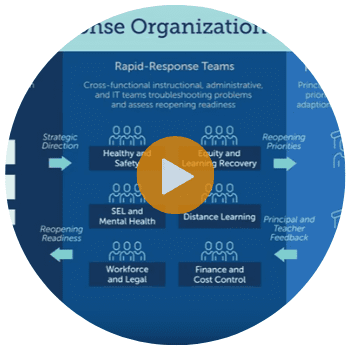The Rapid Response District: Redefining district strategy in the wake of COVID-19
Over the past five weeks, my EAB colleagues and I have talked to dozens of district leaders about their needs and ideas to support students and staff through the coronavirus outbreak. Through these conversations, it has become clear that everyone is asking the same questions:
- How can we make distance learning sustainable and equitable?
- When will it be safe to reopen?
- How can we protect the physical and emotional health of our students and staff?
- How should we assess and make up for lost learning to mitigate the COVID slide?
- What will economic pressures mean for community well-being and district budgets?
The answers to many of these questions will depend on how the following months unfold. There is so much that we cannot predict about the virus, the economy, and government actions. To complicate issues further, each of these factors is likely to play out differently across, and even within, our states.
This unprecedented level of uncertainty means that traditional district summer planning will no longer suffice. Districts and their schools must adapt quickly to conditions as they develop, which means planning for many potential futures. So, while superintendents want answers to the questions above, they are also telling us what they need right now are new ways to plan and execute—to develop what many district leaders are describing as a rapid response organization.
Build a “Rapid Response District”
Enabling a large institution, such as a school district, to respond rapidly to change and thrive through uncertainty requires an organizational structure that promotes alignment, collaboration, and clear feedback all the way from the superintendent to the classroom and back again. To achieve this goal, districts must also form several clearly defined teams with distinct sets of skills and capabilities.
This small, senior group—led by the superintendent in coordination with key cabinet members—sets the strategic direction for the district. To successfully prepare their district for the months ahead, the control tower team must:
- Develop strategies and plans for multiple scenarios
- Establish and launch rapid response teams around critical issues
- Determine criteria for reopening and certify that they have been achieved
- Ensure that stimulus funds are spent in ways that achieve maximum effect
These cross-functional groups of instructional, administrative, and IT experts are charged with handling week-to-week problems. Perhaps more importantly, however, they must also determine the plans for how their district will achieve reopening readiness. The number of rapid response teams will vary by district but there will typically be 4-6 of these units, organized around themes such as:
- Health & safety
- Mental health
- Equity and learning recovery
- Workforce and legal issues
- Distancelearning
- District finances and cost control
Even the best strategies are useless if they fail to translate into action. Unfortunately, we often hear that professional development for principals and teachers is not aligned with strategic priorities or is nonexistent. Rapid Response Districts are guiding professional development toward the skills we know will be critical in the fall, including:
- Preventing teacher burnout
- Serving students with Individual Education Programs (IEPs)
- Managing the behavior of returning students
- Optimizing distance learning in the event of continued or future closures
If implemented correctly, aligned PLCs will be connected to, and included in, discussions about district strategy. This will increase the likelihood that members will execute at a high level and serve as evangelists for key initiatives. PLCs will also play a crucial role in providing timely feedback on teacher engagement and urgent needs for additional training.
The last group in this organizational model is the critically important transformation team. This individual or small team is insulated from daily crisis management so they can think 18 months in the future. Their primary responsibility will be to develop roadmaps for ensuring that innovations born out of the coronavirus crisis become permanent parts of their district’s playbook. EAB’s most progressive partners say that COVID-19’s silver lining is the opportunity to pursue new teaching models that will leave schools stronger than they were in 2019.
How EAB will enable rapid response transformations
District leaders are telling us that a “rapid response organization” is what they need to successfully navigate the weeks and months ahead. They are also telling us that to achieve that goal, they will need quick access to the tools and support that will enable them to stand up these collaborative teams in record time. Therefore, over the coming weeks and months, EAB will provide the following, planning tools, and peer communities to support cabinets, boards, and teams.
Control Tower
- Scenario planning workshops
- Board presentations
- Resource allocation guidance
- Leadership circles
Rapid Response Teams
- COVID-19 resource center
- Readiness diagnostic
- EAB plan reviews
- Readiness plan “certification”
Aligned PLCs
- Best practice workshops
- Teacher engagement resource center
- Turnkey surveys based on best practice research
More Blogs

From building managers to strategic leaders

From cell phones to STEM: What district leaders are focused on right now

